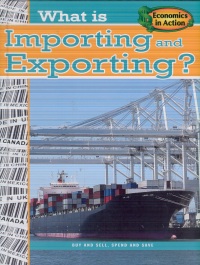| ________________
CM . . .
. Volume XVI Number 36. . . .May 21, 2010
excerpt:
The boom and bust cycles in the world economy occur more frequently than ever before. The resulting changes mean that people may have to work at several occupations in a lifetime. The days of graduating from school and getting a job for life with a secure pension are over as companies go in and out of business and governments whittle away at previously secure social programs. Changes in the economy filter down through the family. Thatís why itís a good idea to educate children at an early age about the basics of the costs of living and how the larger economy works. As children grow and mature, they will be better able to make informed decisions about their own futures. The ďEconomics in ActionĒ series by Crabtree provides an understanding of this complex topic for children in grades 3-6. Using language carefully chosen so as not to overwhelm or frighten a young child (the thought of owing more money than one is earning is scary), the titles outline the operation of personal finances, how the goods we consume get to us, and why they cost what they do. Each two-page chapter in the 32-page books offers clear explanations from which children can make reasoned conclusions. Some people make the mistake of paying only the minimum payments on their credit cards each month. Hereís a simple way to think about it. Letís say you were paying off a loan of $200, with a 10 percent annual interest rate, by making only the minimum payment of $20 a month. Because of the added interest, it would take you about eleven months to pay off the loan and cost you an extra $10.24 in interest. Just think if the annual percentage rate were 18 percent. You would be paying an extra $20.23 in interest. Ouch. Thatís a lot of interest for a $200 purchase. (From How do Mortgages, Loans and Credit Work?.) Most kids get jobs by the time they are 16-years-old and have money to spend. New clothes, toys and the latest techno-gadget are tantalizing. The cost of credit is important to understand, with kids targeted by banks and other financial institutions to use debit and credit cards as soon as they reach certain ages. Teachers can use this series to set up mock situations in elementary school to plant the seed of caution, to prevent kids from spending every penny they earn when they reach their teens. Each chapter contains boxed information relating to the chapter heading, For example, in What is Insurance?, readers learn the variables that determine how much insurance will cost, that the cost of the policy grows with higher factors, and more. Another box provides the history of the first insurance, tracing it back to King Hammurabi of Babylon. In each book, a two-page glossary defines terms bolded in the text. Teachers conducting a unit on consumer math or life skills will find this series helpful. Recommended. Harriet Zaidman is a teacher-librarian in Winnipeg, MB.
To comment
on this title or this review, send mail to cm@umanitoba.ca.
Copyright © the Manitoba Library Association. Reproduction for personal
use is permitted only if this copyright notice is maintained. Any
other reproduction is prohibited without permission.
NEXT REVIEW |
TABLE OF CONTENTS FOR THIS ISSUE
- May 21, 2010.
AUTHORS |
TITLES |
MEDIA REVIEWS |
PROFILES |
BACK ISSUES |
SEARCH |
CMARCHIVE |
HOME |



